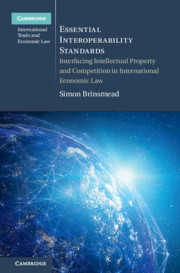 Essential Interoperability Standards
Essential Interoperability Standards from Part II - The Impact of Intellectual Property and Competition Laws
Published online by Cambridge University Press: 26 October 2021
This chapter introduces the concept of standards-essential intellectual property (SEIP), including standards-essential patents (SEPs), standards-essential copyrights, and other applicable forms of IP. The chapter includes detailed consideration of SEPs – including a survey of scholarship of well-documented issues such as patent holdup, royalty stacking, component patenting and patent thickets – not neglecting also the availability of collective rights organizations, e.g. patent pools. Consideration is also given to applicable limiting doctrines in patent law such as defences for experimental use, as well as fundamental principles such as the requirement to publish. Detailed consideration is given to patent remedies, notably injunction and damages; compulsory licencing is also discussed. Likewise, copyright laws are considered carefully. Likewise, copyright laws are considered carefully. There is discussion of the particular situation of copyrights in relation to software and the structure of databases. There is also consideration of layout circuit and trade secret laws, as well as compulsory licensing.
To save this book to your Kindle, first ensure [email protected] is added to your Approved Personal Document E-mail List under your Personal Document Settings on the Manage Your Content and Devices page of your Amazon account. Then enter the ‘name’ part of your Kindle email address below. Find out more about saving to your Kindle.
Note you can select to save to either the @free.kindle.com or @kindle.com variations. ‘@free.kindle.com’ emails are free but can only be saved to your device when it is connected to wi-fi. ‘@kindle.com’ emails can be delivered even when you are not connected to wi-fi, but note that service fees apply.
Find out more about the Kindle Personal Document Service.
To save content items to your account, please confirm that you agree to abide by our usage policies. If this is the first time you use this feature, you will be asked to authorise Cambridge Core to connect with your account. Find out more about saving content to Dropbox.
To save content items to your account, please confirm that you agree to abide by our usage policies. If this is the first time you use this feature, you will be asked to authorise Cambridge Core to connect with your account. Find out more about saving content to Google Drive.